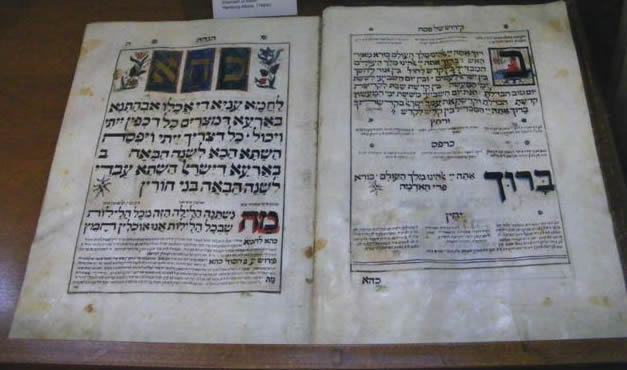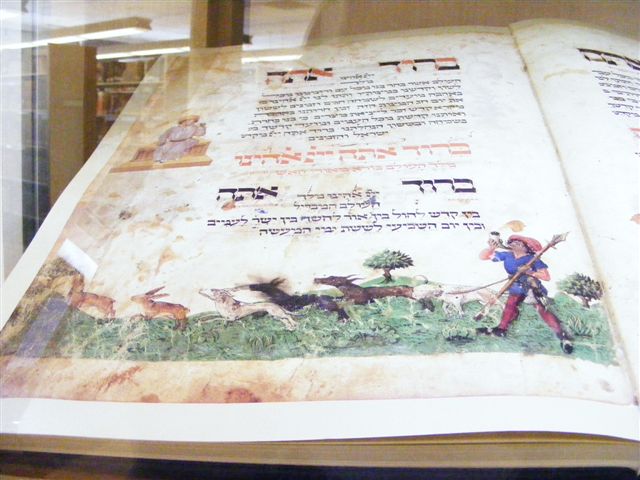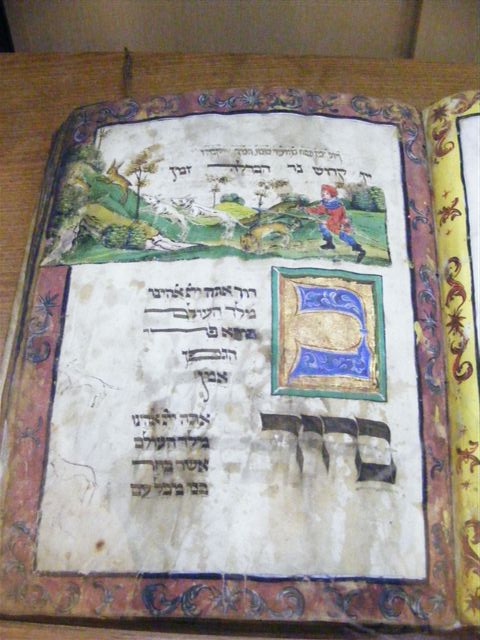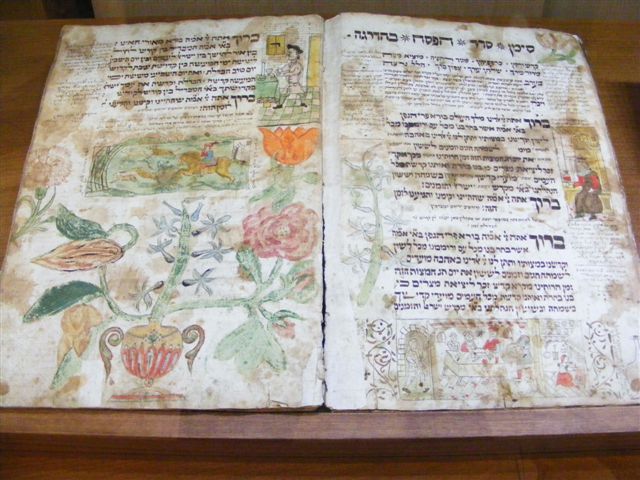 Just why are there so many rabbit hunting scenes in early Haggadot? The Klau Cincinnati Library explores this question in their latest exhibit.
Just why are there so many rabbit hunting scenes in early Haggadot? The Klau Cincinnati Library explores this question in their latest exhibit.
The term YaKNeHaZ—also pronounced YaKN-HaZ—is an acronym composed of the initial letters of five Hebrew words: yayin, kiddush, ner, havdalah, zeman. It is a “seman,” a mnemonic aid to remembering the correct order of the blessings of the kiddush and the havdalah when Passover coincides with the conclusion of Shabbat. If we tum to the Babylonian Talmud, tractate Pesahim, 102b-103a, we learn that Abaye taught that the correct order for these prayers was YaKaZNaH; while Rabba maintained it was YaKNeHaZ, and the halachah is according to Rabba.
In the earliest manuscript siddurim and haggadot, including the Mahzor Vitri and the Seder Rav Amram Gaon, as well as the Birds Head Haggadah and the Kauffmann Haggadah, the seman YakNeHaZ appears either before or immediately after the kiddush and havdalah prayers. This practice of including this seman continued through the centuries in both manuscript and then printed haggadot, but began to disappear from printed haggadot in the nineteenth century
YakNeHaZ sounds similar to the German phrase “jag den Häs, hunt the hare.” At some time unknown to us, and most likely in a German- speaking region, an artist illuminating a Haggadah decided that the insertion of a hare-hunt scene at this point in the liturgy was a suitably amusing piece of artistic whimsy, a punning pictorial witticism.
We have no data that reveals exactly when some illuminator first inserted a hare-hunt scene in a Haggadah adjacent to the seman yaknehaz or the kiddush which includes the havdalah.
Indeed, the attempt to find some solution to this question is potentially clouded by the prevalence of hare-hunting scenes in the broad genre of European manuscript illustration and in the narrower area of Jewish illuminated manuscripts. From the pre-Carolingian era, the hare hunt was a recurring motif in European illuminated manuscripts. In one type of image, a dog or dogs chase a hare or hares. In another, individuals, armed with various weapons and accompanied by dogs, chase after a hare or hares. In one style the hunter holds a boar spear—a spear with a large head and a cross-piece to prevent a charging boar “running-up” the spear and goring the hunter with its tusks—which certainly seems to be ironic overkill when hunting a rabbit!

Hamburg-Altona. 1740/1741. Written and illuminated by Jankew Sofer ben Rabbi Judah Loeb, Shamash of Berlin.

In the Ashkenazi Haggadah, produced in the south of Germany around 1460 and illustrated by Joel ben Simeon Feibusch, there is neither liturgical direction nor seman; the illustration appears on the bottom of the page which contains the blessing for ner, and part of the havdalah. The image itself has come to represent the vocalization of the seman, that is “jag den Häs = YaKNHa”Z.”

First Cincinnati Haggadah. 15th century. In this famous example from the First Cincinnati Haggadah, produced in southern Germany towards the end of the fifteenth century, we see that the scribe, Meir ben Israel Jaffe of Heidelberg, has written the seman as part of his liturgical directions, and then "spelledout" the seman underneath as five words. Immediately under these words is the hare-hunt scene.

Like the Ashkenazi Haggadah, the Washington Haggadah was also illuminated by Joel ben Simeon. As is common in medieval Haggadah illustration, we see an armed man next to the beginning of the paragraph beginning “Tse, u-lemad, Go forth and learn what Laban the Aramean sought to do to Jacob our father. Pharaoh only decreed concerning the males; but Laban sought to destroy all, as it is written ‘An Aramaean destroying my father’. " If you look carefully, you will see that the drawing of a hare has been incorporated into the rubrication surrounding the word "va-yered'' beginning the very next paragraph. What we have here in the Washington Haggadah is a "hare hunt," with a hunter and a hare. The image of the armed man represents Laban, who is out hunting for Jacob, represented here by the rabbit hiding in the rubrication.

Moss Haggadah. When European Jews included hare hunt scenes in their Haggadot, I suspected that their sympathies lay with the hare! It seems to me that this apparently incongruous hare-hunting scene found its way into these European Haggadot precisely because it represented the image of the persecuted Jews. I became suddenly obsessed with images of hares and their relentless huntsmen. Then, at one point, my focus shifted from the human hunter of the hare to its natural predators. I caught a glimpse of a stark and powerful new image: that of the eagle. I began tracking down this bird of prey in zoology and mythology, heraldry and human history. I’ve collected some of these images on page 7b, adding only the hares which appear in the eagles’ clutches. … The last panel shows the hare which, always, somehow, manages to escape." —David Moss, A Song of David, Commentary

Barcelona Haggadah. The Barcelona Haggadah is a most exquisite fifteenth century work produced in the Catalan region of Spain. There are several different types of hound-hunter-hare vignettes that are depicted in this work. On the YaKeNHaZ page, one hound has caught sight of a hare, the other just sits there. On the facing page, in the bottom left, we see a rabbit emerging from the foliage; the rabbit seems to be chasing the dog. In the left panel, a dog with a hunting horn and a shield and dagger seems ready to do battle with a rabbit, armed either with a carrot or some sort of spear head. On the page following the kiddush for weeknight, at the bottom of the page, we see a hunter, with horn, and a staff from which seem to hang hares already caught. We also have a pack of hounds, and a hare.

Sarajevo Haggadah. Perhaps the single best known Jewish illuminated manuscript is the Sarajevo Hagadah, produced in Spain during the 14th century. We see here a hound chasing a hare, separated by the words "min ha'aretz." Turning back to the preceding page, we find the motivation for this image in the text, where the Egyptians plot the destruction of the Israelites: "... Let us, then, deal shrewdly with them, lest they increase, and in the event of war, join our enemies in fighting against us and gain ascendancy over the country." Egypt is the dog; Israel the hare. The phrase "gain ascendancy over the country" translates the Hebrew "ve-'alah min ha-'aretz,” which can be rendered literally: “And he sprang up from the earth." The hound takes off after the rabbit as it springs up from cover.

